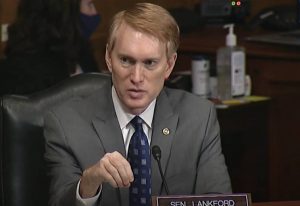
As Congress explores the coronavirus pandemic, the one that shut down much of the nation’s oil and gas industry not to mention the critical impact it had on wind and solar energy development, Oklahoma U.S. Sen. James Lankford had some pointed questions during a Senate hearing this week.
It was during a Homeland Security and Governmental Affairs Committee hearing entitled, “Evaluating the Federal Government’s Procurement and Distribution Strategies.”
Lankford’s Q&A for the panel including procurement and distribution leaders from the Departments of Homeland Security, Defense, and Health and Human Services focused on federal procurement processes, procedures, and obstacles during the COVID-19 pandemic and how we can be better prepared for any future pandemic or another emergency.
Lankford, who chairs the Subcommittee on Regulatory Affairs and Federal Management, sent a letter last month with Ranking Member Kyrsten Sinema (D-AZ) to the Government Accountability Office (GAO) to examine the federal government’s response to the coronavirus outbreak in the US and provide recommendations to improve America’s preparedness for a future pandemic or public health emergency.
Excerpts
On availability of syringes in advance of COVID-19 vaccine
(03:05 – 03:40) Lankford: Are we at a point right now that if we had a vaccine let’s say in November that we’d have enough syringes and distribution to get it out.
Rear Admiral John Polowczyk, Vice Director of Logistics, Joint Chiefs of Staff, Dept. of Defense: Sir, to answer that specifically, we’re on a glide path to have approximately 400 million needles and syringes by, I’ll say, December. I don’t have the numbers right in front of me, but it’s at least 400 million as we get into the winter and 700 and some-odd million as we get into the summer.
On domestic manufacturing
(06:11 – 06:50) Lankford: We have got to relook again at something this Committee can continue to work on—and thank you Mr. Chairman for this’s Committee’s work on this area—but dealing with domestic manufacturing. All of the things that we had to get with an air bridge to be able to ship over in a moment of pandemic, I would suggest every one of those supplies we should re-examine: what is our domestic manufacturing for those supplies, that we were in such a desperate moment that we had to be able to move those via an air bridge from Asia? Why aren’t we producing those domestically, and what can we do to create more domestic supply on those, so that we can ramp up working nights and weekends, rather than ramping up to be able to move them over from Asia at a point when we’re exposed on this.
On the VA health system distribution process(07:28 – 07:57) Lankford: How do we bump up the numbers that are available to VA as we’ve got a complicated process where HHS decides, FEMA distributes, it gets down to the VA, then VA distributes down to the individual hospitals and clinics?
The Honorable Brett Giroir, M.D., Assistant Secretary for Health, Dept. of Health and Human Services: Thank you for that question, and it’s good to shed some light on that. Dr. Stone, who is the Chief Executive of the Veterans Health Administration, and I talk regularly. The VA makes a request, and we fulfill it. That’s just that clear. If they need 100,000 swabs, then we give them 100,000 swabs.
Click here to view video of the Senator’s questioning.
Source: Sen. Lankford’s office





